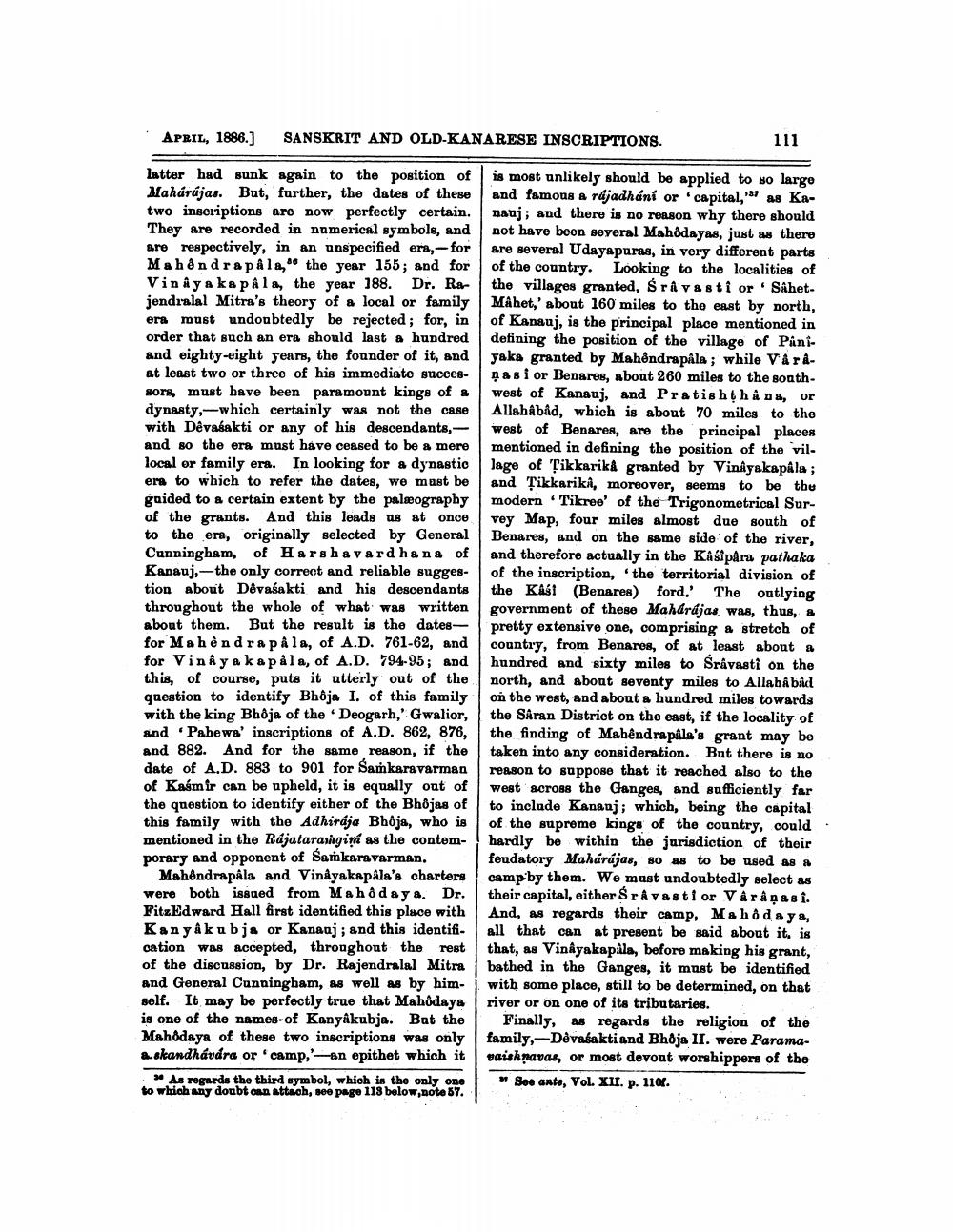________________
APRIL, 1886.]
SANSKRIT AND OLD-KANARESE INSCRIPTIONS.
111
latter had sunk again to the position of is most unlikely should be applied to wo largo Mahúrájas. But, further, the dates of these and famous a rdjadhúní or capital, as Katwo inscriptions are now perfectly certain. nauj; and there is no reason why there should They are recorded in numerical symbols, and not have been several Mahôdayas, just as there are respectively, in an unspecified era,- for are several Udayapuras, in very different parts Mahendra påla," the year 155; and for of the country. Looking to the localities of Vinaya kapal, the year 188. Dr. Rar the villages granted, Srivasti or SÂhet. jendralal Mitra's theory of a local or family MAhet,' about 160 miles to the east by north, era must undoubtedly be rejected; for, in of Kanauj, is the principal place mentioned in order that such an era should last a hundred defining the position of the village of Paniand eighty-eight years, the founder of it, and yaka granted by Mahendrapala ; while Variat least two or three of his immediate succes- ņ&si or Benares, about 260 miles to the southsors, must have been paramount kings of a west of Kanauj, and Pratishthana, or dynasty, which certainly was not the case AllahAbåd, which is about 70 miles to the with Devasakti or any of his descendants, west of Benares, are the principal places and so the era must have ceased to be a mere mentioned in defining the position of the villocal or family era. In looking for a dynastic lage of fikkarikå granted by Vinayakapala; era to which to refer the dates, we must be and Tikkarika, moreover, seems to be thu guided to a certain extent by the palæography modern Tikree' of the Trigonometrical Surof the grants. And this leads us at once vey Map, four miles almost due south of to the era, originally selected by General Benares, and on the same side of the river, Cunningham, of Harsha vardhana of and therefore actually in the Kasipâra pathaka Kananj,--the only correct and reliable sugges- of the inscription, the territorial division of tion about Dévasakti and his descendants the Kasi (Benares) ford. The outlying throughout the whole of what was written government of these Mahardjas, was, thus, a about them. But the result is the dates- pretty extensive one, comprising a stretch of for Mahendra påla, of A.D. 761-62, and country, from Benares, of at least about a for Vinaya kapala, of A.D. 794-95; and hundred and sixty miles to Sravasti on the this, of course, puts it utterly out of the north, and about seventy miles to AllahAbad question to identify Bhoja I. of this family on the west, and about a hundred miles towards with the king Bhôja of the Deogarh,' Gwalior, the Saran District on the east, if the locality of and Pahewa' inscriptions of A.D. 862, 876, the finding of Mahendrapala's grant may be and 882. And for the same reason, if the taken into any consideration. But there is no date of A.D. 883 to 901 for Samkaravarman reason to suppose that it reached also to the of Kasmir can be upheld, it is equally out of west across the Ganges, and sufficiently far the question to identify either of the Bhājas of to include Kananj; which, being the capital this family with the Adhirája Bhoja, who is of the supreme kings of the country, could mentioned in the Rdjatarasagim as the contem- hardly be within the jurisdiction of their porary and opponent of Sankaravarman, fendatory Mahárájas, so as to be used as a
Mahendrapala and Vinayakapala's charters camp by them. We must undoubtedly select as were both issued from Mahodaya. Dr. their capital, either Sråvasti or Vår åpas i. FitzEdward Hall first identified this place with And, as regards their camp, Mahôdaya, Kanyaku bjs or Kananj; and this identifi. all that can at present be said about it, is cation was accepted, throughout the rest that, as Vinayakapala, before making his grant, of the discussion, by Dr. Rajendralal Mitra bathed in the Ganges, it must be identified and General Cunningham, as well as by him- with some place, still to be determined, on that self. It may be perfectly true that Mahôdaya river or on one of its tributaries. is one of the names of Kanyakubja. Bat the Finally, as regards the religion of the Mahôdaya of these two inscriptions was only family, -Devasakti and Bhoja II. were Paramaa skandhávára or camp,'- an epithet which it vaishnavas, or most devout worshippers of the
As regards the third symbol, which in the only one * See ante, Vol. XII. p. 110. to which any doubt an attach, see page 118 below,note 87.1




